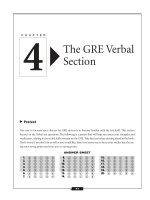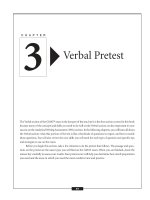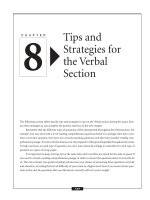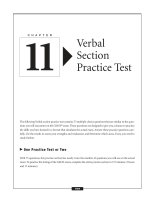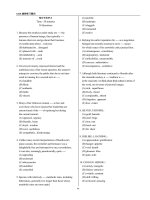Gre verbal section 4 potx
Bạn đang xem bản rút gọn của tài liệu. Xem và tải ngay bản đầy đủ của tài liệu tại đây (82.08 KB, 6 trang )
relationship of contrast, or opposition. No matter how complex a sentence completion sentence seems at first
glance, when you see one of these words or phrases, you will know you are looking at a sentence that expresses
one thought in its complete unit and a contrasting thought in its incomplete unit. First, decipher the thought
in the complete unit, then fill in the blank in the incomplete unit with a word that expresses a contrasting
thought. For example:
Although the tiger is primarily a solitary beast, its cousin the lion is a ________ animal.
Next, divide the sentence into two units, using the punctuation to guide you. Now you have as the first unit,
Although the tiger is primarily a solitary beast, and the second unit, its cousin the lion is a ________ animal.
The first unit tells you, by the use of although, that the second unit will express a relationship of opposition
or contrast. You can see that tigers and lions are being contrasted. The word that goes in the blank has to be
an adjective that describes animal in the way that solitary describes beast. Therefore, the word that will con-
trast with the idea in the first unit is in opposition to solitary. What is an antonym of solitary? Solitary means
alone. You might choose the antonym social. Friendly, gregarious, or sociable are other options, all meaning
not solitary. Then, look for the word in the answer choices that is a synonym of the word you chose.
C
OMPARISON
There are two kinds of comparison relationships: comparison by similarity and comparison by restatement.
Words that signal comparison are words such as likewise, similarly, and and itself. Phrases that introduce compar-
isons include just as, as _______ as, for example, as shown, and as illustrated by. An example of a comparison
by similarity sentence would be: Always be sure to treat other people ______; for example, hold the door open
for the person behind you. You know that holding the door is a kind or polite thing to do, so you will be look-
ing for a word like politely, kindly,or respectfully to complete the first part of the sentence.
Words and phrases that precede restatement are namely, in other words, in fact, and that is. One exam-
ple of a comparison by restatement sentence would be: Julie was ____ over the outcome of the election; in fact,
it was all she could do to keep from screaming. The complete part of the sentence tells you that Julie was very
upset, so you know that you will be looking for an answer choice like angry, livid, or frustrated to complete
the idea in the first half of the sentence.
Relationships of logical comparison are straightforward. The idea expressed in the complete unit of the
sentence is similar to or the same as the idea that needs to be expressed in the incomplete unit. When you
know what the complete unit says, you know what the incomplete unit needs to say—the same thing, or very
nearly so. The following is an example of a comparison sentence.
Until he went to military school, Foster never stood up straight, as illustrated by his ________ in
this photograph.
This sentence has three units, two complete and one incomplete. The first two units tell you that before
military school, Foster slouched. The blank in the third unit, therefore, needs to be filled by a word that will
illustrate his slouching. The correct answer will be posture, slouch, or a synonym.
– THE GRE VERBAL SECTION–
105
CAUSE AND
EFFECT
A third kind of logical relationship often expressed in sentence completion questions is the cause and effect
relationship. In other words, the sentence states that one thing is a result of something else. Again, key words
will point you in the right direction. Words such as thus, therefore, consequently, and because and phrases such
as due to, as a result, and leads to signal cause and effect. Try making some cause and effect sentences to see
how they work.
Here’s an example of a cause and effect sentence:
Scientific knowledge is usually _______, resulting often from years of hard work by numerous
investigators.
The complete unit of the sentence, resulting often from years of hard work by numerous investigators, tells
you that the other unit results from numerous investigators working hard for years. The incomplete unit, the
one with the blank, tells you that you are looking for a word to describe scientific knowledge that resulted from
those years of hard work. You know that whatever word the test makers are looking for must have something
to do with the accumulation of lots of stuff, because years of hard work by numerous investigators would pro-
duce a lot of something. The correct answer choice for this question, you may remember, was cumulative,
which, of course, applies to the accumulation of lots of stuff.
Transitions
Transitions are an essential element of effective writing, and they are important clues to organizational pat-
terns and meaning. Transitions signal the relationships between ideas; that is, they connect ideas within sen-
tences and between sentences or within paragraphs and between paragraphs. They tell us the order in which
things happened, whether one idea is more important than another, or how one item is similar to or differ-
ent from something else.
For example, notice how transitions guide us through the following paragraph:
(1) Why do we punish those who commit crimes? (2) There are two main theories of pun-
ishment: retribution and deterrence. (3) The first, retribution, argues that people who com-
mit crimes deserve to be punished and that the punishment should fit the crime. (4) In other
words, it is an “eye for an eye” philosophy. (5) Deterrence theory, on the other hand, posits
that punishing offenders will help prevent future crimes.
The transitions here show us that sentence 4 offers an explanation for sentence 3 and that sentence 5
offers an idea that contrasts with the idea in sentence 3.
Certain transitions work best for specific functions. For example, for example is a great transition to use
when introducing a specific example. Here is a brief list of some of the most common transitional words and
phrases to watch for—and to use in your own writing.
– THE GRE VERBAL SECTION–
106
IF YOU WANT TO: USE THESE TRANSITIONAL WORDS AND PHRASES:
introduce an example for example for instance that is
in other words in particular specifically
in fact first, second, third
show addition and in addition also
again moreover furthermore
show emphasis indeed in fact certainly
acknowledge another although though granted
point of view
despite even though
show rank more importantly above all first and foremost
most importantly first, second, third
show cause because since created (by)
show effect therefore hence so
consequently as a result
show comparison likewise similarly like
in the same way in a like manner just as
show contrast unlike however on the other hand
whereas instead rather
but on the contrary conversely
in contrast yet
show the passage of time then next later
after before during
meanwhile while soon
eventually finally afterward
in the meantime immediately suddenly
– THE GRE VERBAL SECTION–
107
Signal Words
Contrast: although, but, despite, however, yet, though
Comparison: likewise, just as, similarly, for example, as illustrated by, and, as ____ as
Restatement: in other words, namely, that is
Cause and Effect: as a result, due to, therefore, thus, leads to, because, consequently
108
Putting It All Together
Once you learn how to identify the complete and incomplete units of a sentence, using punctuation to guide
you, you have made a good start. Next, by determining the logical relationship of the units, using key words
and phrases, you then understand what the sentence is saying, even if there’s some vocabulary you don’t under-
stand. But if you keep building your vocabulary, chances are, you will understand the crucial words.
The Top Seven Steps for Answering Sentence
Completion Questions
When you break up sentences using punctuation as a guide, you end up with more or less manageable chunks
of words. Nevertheless, when you have a 25-word sentence, which is not that uncommon on the GRE, and
you break it into two units, you can still easily have a 12-to-15-word unit. On the real GRE, there have even
been 20-to-30-word sentences with no punctuation except for the period at the end.
These long sentences are further complicated by the fact that they often include difficult vocabulary. See-
ing words you don’t know may send your anxiety level soaring, and nobody does his or her best work when
anxious. With practice, though, you can learn to take those long sentences and unknown words in stride. Try
following these seven steps:
1. Start small. Don’t tackle the whole sentence at once. There are several techniques to help you break
sentences into smaller units. Using punctuation to guide you, as demonstrated in the previous sec-
tion, is the most obvious method. If the guiding commas and semicolons aren’t there, however, you
will need to look for other places to break a sentence. One technique is to find a verb and gradually
incorporate the words around it into an increasingly longer phrase as you decipher its meaning. The
verb provides an anchor for the meaning because it tells you what is being done.
You can also use trial and error to find islands of meaning in a sentence. Find a word or a phrase
you understand and start adding a word or two on either side. As you discover several such islands and
gradually enlarge each one, you will eventually see how they fit together, and then you will understand
the dynamics of the whole sentence.
2. If the vocabulary in a sentence is a problem, look at the words around it. Usually, you can figure out
what function a word is serving in the sentence. Ask yourself whether it’s an action word. If so, it’s a
verb. Is it describing something? Then it’s an adjective or adverb. Is it the subject—the person, place,
or thing performing the action in the sentence? It’s a noun or pronoun. Use the surrounding context
to help you guess the meaning or at least the part of speech of an unfamiliar word.
3. As you are reading a sentence with blanks or with words you don’t know (which might as well be
blanks!), it can ease your anxiety to substitute words or sounds of your choice in place of the
unknown words. The words something and whatever work well in many situations. You may find you
prefer nonsense words instead, such as yada yada or blah blah. As the meaning of the sentence gradu-
ally becomes clear, you can start substituting words that might work in the sentence. Eliminate all
answers that do not have the correct part of speech for the blank.
4. Now that you have a good idea about the gist of the sentence, it’s time to think about filling in the blanks.
It is crucial at this point that you do not look at the answers! Because the GRE has so many distracter
answers, which will look right if you have not deciphered the meaning of the sentence, it would be a mis-
take to look at the answers to see what word(s) might go in the blank(s). You have to decide first what the
answer needs to express. Then you can look at the answer choices to find one that matches your idea. It is
not important that you come up with the perfect single word to express your idea. A phrase is fine, as
long as you are clearly expressing the meaning you think the correct answer choice will express.
5. As you are deciding on the correct idea for the blank or blanks to express, be sure you are sticking to what
is expressed in the sentence. Don’t let the idea(s) in the sentence lead you off into another area. Perhaps the
sentence reminds you of something you have read or heard that would perfectly complement the idea(s) in
the sentence.Your information may be true, but it’s a mistake to use your outside knowledge in completing
a sentence. Remember that there will often be key words or phrases signaling the relationship of the various
parts of the sentence. And there will always be enough information within the sentence so that you can
answer without having any outside knowledge. Stick to the information within the sentence itself.
6. Once you think you know what idea the answer word needs to express, look at the answers. If you see
an answer choice that seems to match your idea, try plugging the answer into the sentence to see if it is
internally consistent. That means, check to see if it fits into the sentence without introducing any new
idea. If it seems to fit, but brings in an idea you can’t find anywhere else in the sentence, it’s the wrong
answer.
7. If you can’t settle on an absolutely correct answer, use the process of elimination. Once you have deci-
phered the meaning of the sentence, break it apart and fit it back together. Chances are, you will
immediately see one or two answers that make no sense within the existing framework of the sentence.
Eliminate all answers that don’t fit the meaning of the sentence.
When you eliminate an answer, make a note of it. As you are working on a challenging question, use
your scratch paper to write a, b, c, d, and e and then cross out incorrect choices, mark them off the list,
eliminate them from your consciousness. You no longer need to consider them, so don’t let those
incorrect answers slow down your thought process by continuing to exist as possibilities. Promise
yourself, however, that you will never eliminate an answer choice just because you don’t know the
vocabulary. Sometimes, in fact, you will be able to eliminate all the other answers, leaving you with the
one answer you don’t understand but that must be the correct choice!
A final warning about eliminating answers is that it must always be a conscious choice to eliminate an
answer. Many times, distracter answers are positioned at a or b so that you see them, think hurriedly,“Oh,
– THE GRE VERBAL SECTION–
109
that’s the one!” and move on without even looking at the other answers, including the correct one. Even if
you think you see the correct answer, look at all the answer choices before making your final selection.
When a question has two blanks, you may be able to figure out the answer to one blank but not the
other. If so, that’s good—you can now eliminate all answers that do not fit in that blank. Then you can
continue your efforts by focusing exclusively on the other blank.
How to Approach Reading Comprehension Questions
The Verbal section of the GRE contains at least two reading comprehension passages, each one followed by
questions about the passage. Passages are excerpted from writings in the fields of the humanities and the social
and natural sciences. Each prose passage is 300 to 1,000 words in length, and there will be several questions
(most likely four to seven questions) regarding each one.
The reading comprehension questions test your ability to understand what you read. You will often be
required to identify the author’s main point or purpose in writing the passage. You will also have to accurately
interpret secondary points and even the assumptions that underlie what is explicit in the passage. The ques-
tions will ask you to analyze each passage from several perspectives, including the kinds of research that might
confirm or negate the author’s conclusions.
GRE passages are usually complex and densely packed with ideas, and many are somewhat over-
whelming at first glance. You must be able to extract information, both expressed and implied. You will be
asked about the logical flow of the texts and about their consistency or lack thereof. You may also have to
answer questions about the tone of the passages as well as their overall theme or meaning. You will see phrases
such as the passage implies that . . . and the author suggests that . . . , which require you to extrapolate from the
information given to form your own conclusions.
Finding the Main Idea
Standardized reading comprehension tests always have questions about the main idea of the passage, and for
good reason: The main idea is the key concept or thought that the writer wants to convey in the text.
People often confuse the main idea of a passage with its topic, but they are two very different things. The
topic or subject of a passage is what the passage is about. The main idea, on the other hand, is what the writer
wants to say about that subject. For example, take a look at this paragraph:
Although many social policies and much legislation is founded on this “greatest good” phi-
losophy, there are several problems with utilitarianism as a basis for morality. First, happi-
ness is not so easy to quantify, and any measurement is bound to be subjective. Second, in a
theory that treats everything except happiness as instrumentally rather than intrinsically valu-
able, anything—or, more importantly, anyone—can (and should) be treated as a means to an
end, if it means greater happiness. This rejects the notion that human beings have their own
intrinsic value. Further, utilitarianism puts the burden of the happiness of the masses on the
suffering of the few. Is the happiness of many worth the suffering of a few? Why do those few
– THE GRE VERBAL SECTION–
110


